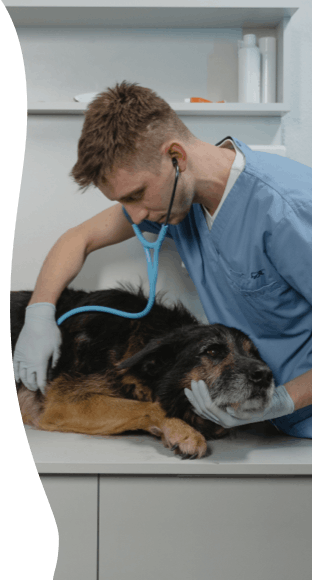How Do You Know if Your Dog Has a Fungal Infection?
What is Fungal Infection ?
Blastomycosis is a fungal infection that occurs predominately in immature dogs that live about a body of h2o, which is where the fungal organism thrives. If left untreated, the infection may spread to the lungs, eyes, and other organs, resulting in blindness, lameness, or death. Antifungal medications may clear out the infection entirely if the organisms are identified early on, and so the sooner your canis familiaris is diagnosed, the better the take a chance of a full recovery.
Blastomycosis is a serious fungal infection that requires immediate handling for a ameliorate prognosis. This status is rare and can easily be misdiagnosed, as it shares symptoms with a variety of other canine illnesses. If you doubtable your dog has been exposed to Blastomyces dermatitidis, let the veterinarian know and asking that your canis familiaris be tested for a fungal infection.
Vet bills can sneak up on you.
Program alee. Get the pawfect insurance programme for your pup.
Compare plans

Fungal Infection Average Cost
From 18 quotes ranging from $500 - $3,000
Boilerplate Cost $800
Symptoms of Fungal Infection in Dogs
Symptoms of a blastomycosis infection include:
- Sluggishness
- Loss of appetite
- Fever
- Weight loss
- Coughing
- Depression
- Eye infection
- Skin lesions
Blastomycosis is often misdiagnosed, in part due to its rarity and in role because information technology mirrors the symptoms of many other conditions. If your dog'due south symptoms persist, and if your canis familiaris has been in an area where you believe Blastomyces dermatitidis may be constitute, ask the veterinary to test for a fungal infection.
Pinnacle
Causes of Fungal Infection in Dogs
Blastomycosis is caused past the fungus Blastomyces dermatitidis, which is plant in rotting wood or wet, sandy soil. When the fungus is disturbed, it releases spores that may and then exist inhaled. This infection primarily affects dogs in sure geographical locations, namely areas near a trunk of water, and seems to occur more frequently in male than female dogs. Hunting and sporting dogs are more than prone to blastomycosis infections due to their activeness in environments where the fungus thrives.
Top
Diagnosis of Fungal Infection in Dogs
If your dog is behaving strangely or showing any unusual signs or symptoms, bring him or her to the veterinarian immediately for an examination. The veterinary will perform a physical test, claret tests, and perhaps urinalysis equally function of the initial visit, though the results will not betoken specifically to a fungal infection.
Blastomycosis is typically identified through cytology, or a close look at the organism under a microscope. When a fungal infection is suspected, the veterinarian will examine the fluid draining from any skin lesions or a tissue sample aspirated from the lymph node or lung. Other potential diagnostic tools include:
- Radiology
- Serology
- Antigen claret or urine test
- Polymerase chain reaction examination
These tests may reveal exposure to the blastomycosis fungal organism, though the results practice not necessarily mean that your domestic dog is infected. The surest way to identify the infection is through an examination of the organism itself.
Top
Treatment of Fungal Infection in Dogs
Depending on the severity of the infection, the veterinarian may prescribe dissimilar antifungal medications to treat it. These drugs volition need to exist administered over the long term to ensure that the fungal organisms are entirely cleared out. Typically, the earlier the infection is detected, the easier it will be to treat.
The about common antifungal drug that is prescribed is itraconazole, which is currently the safest option available. This treatment may be expensive, as the drug needs to be administered for 60 to 90 days and may need to be given in combination with other medications if the infection has spread. Other antifungal drugs include:
- Amphotericin B
- Ketoconazole (Nizoral)
- Fluconazole
Regular examinations by the veterinarian will be required over the grade of treatment to check your dog's response and to monitor the extent of the infection. The drugs will need to be administered even later on all symptoms or signs of the infection take cleared to lower the chance of a relapse.
Summit
Recovery of Fungal Infection in Dogs
Because fungal infections are difficult to clear out, your dog may react poorly to the antifungal medication in the get-go 24 to 72 hours of treatment. Your dog is at highest gamble if the infection has spread to the lungs, as the dying fungal organisms may trigger an inflammatory response. Monitor your dog closely for signs of respiratory distress, and alert your veterinarian immediately if your dog appears to have problem breathing.
Over the form of the treatment, your dog will probable be lethargic and unwilling to consume. Provide a quiet, comfortable identify where your canis familiaris tin can residuum while the antifungal medication takes concur and encourage your dog to consume every bit necessary. If your canis familiaris responds well to treatment by the first week, chances of recovery are high, though there is always the risk of a relapse later the drugs are discontinued.
Top
*Wag! may collect a share of sales or other compensation from the links on this page. Items are sold by the retailer, not Wag!.
Source: https://wagwalking.com/condition/fungal-infection
0 Response to "How Do You Know if Your Dog Has a Fungal Infection?"
Post a Comment